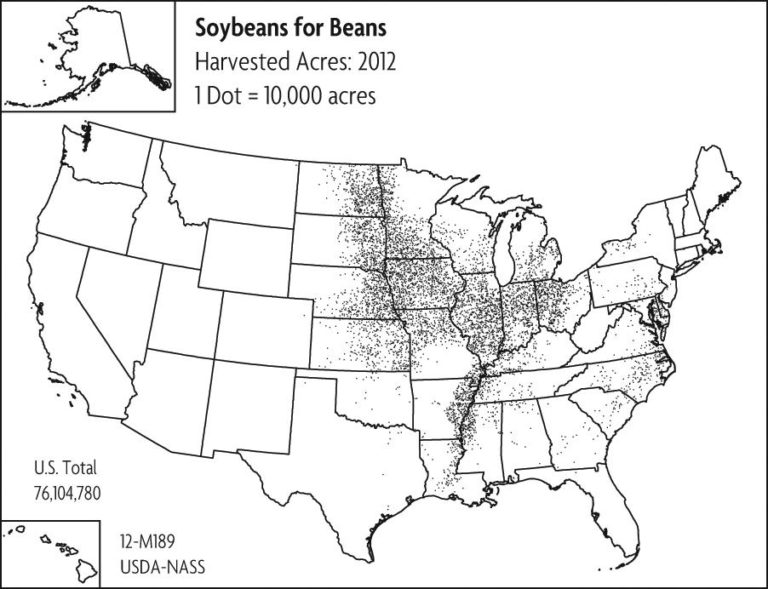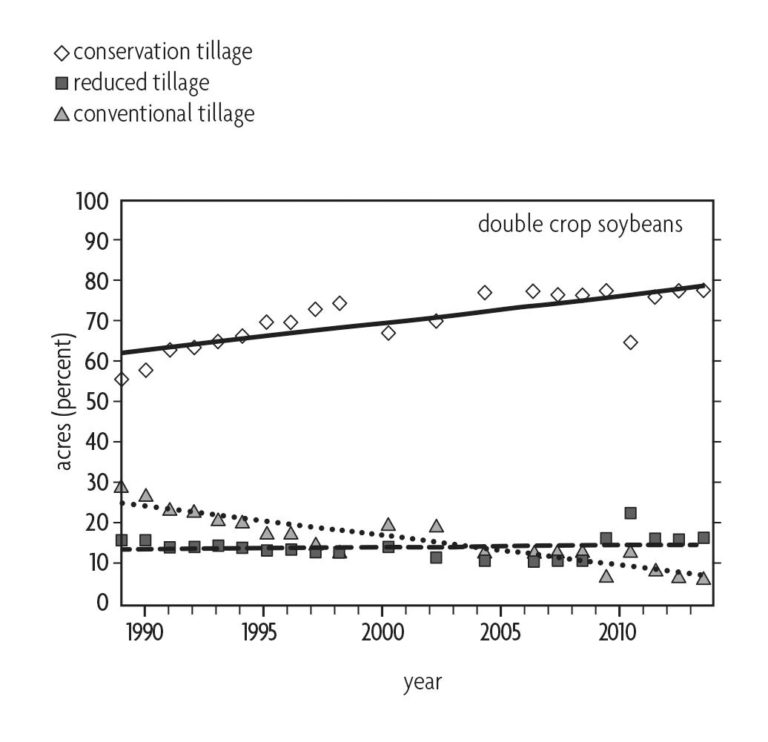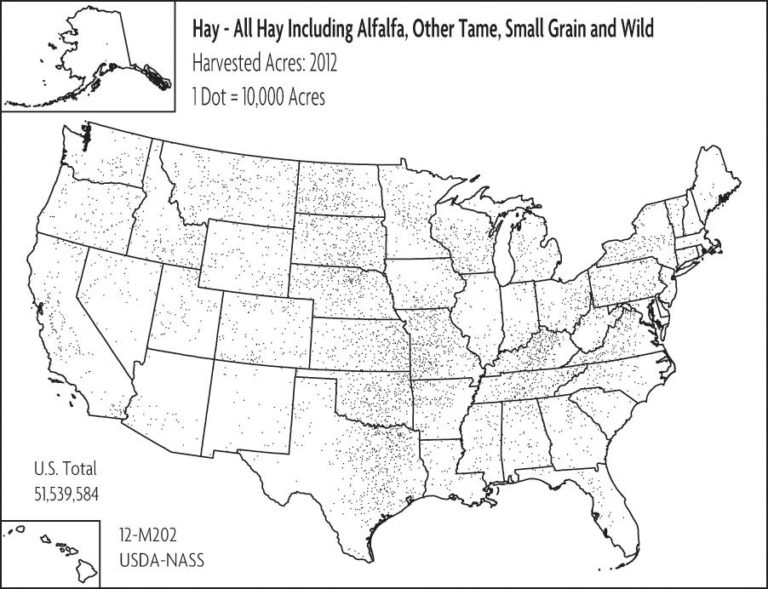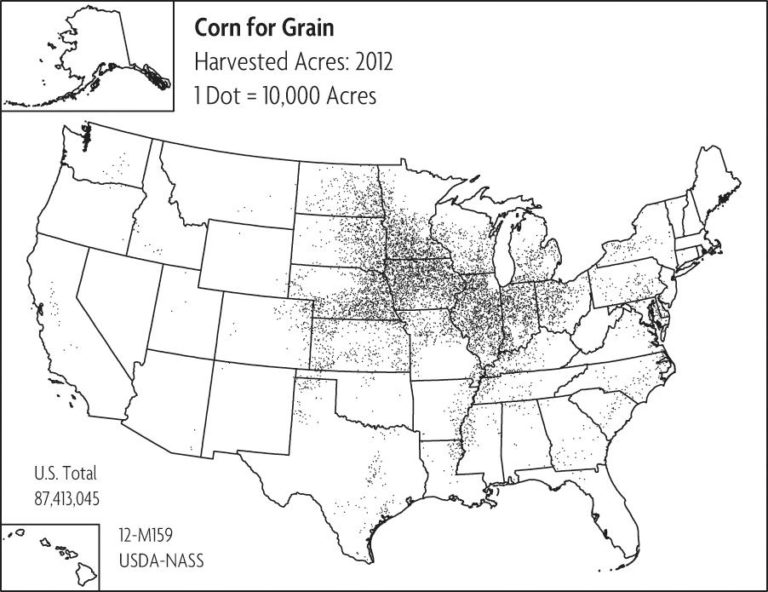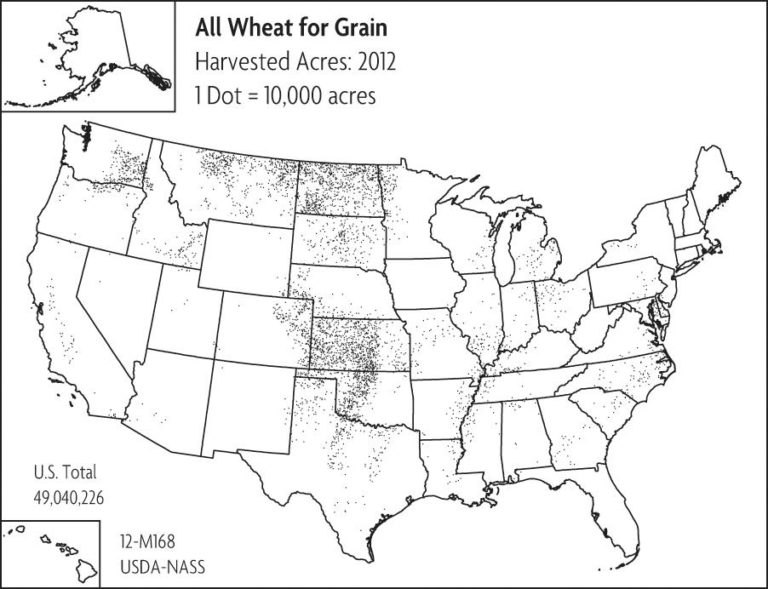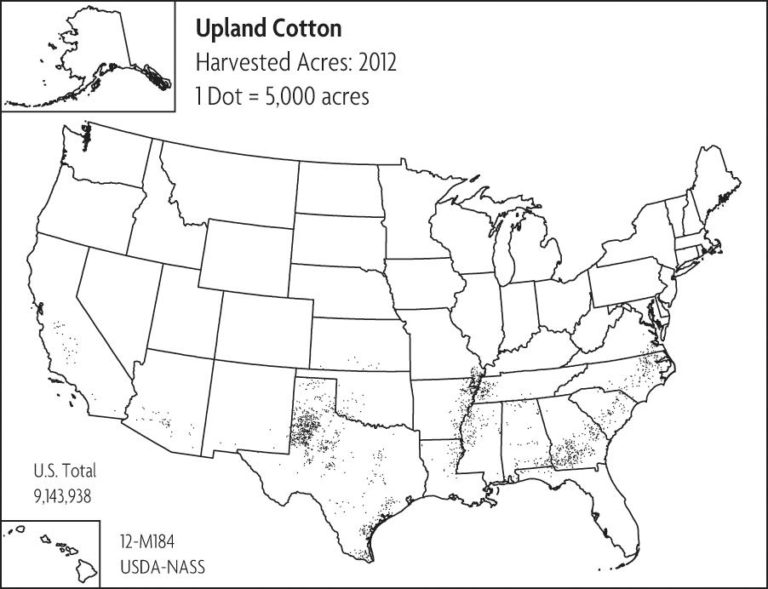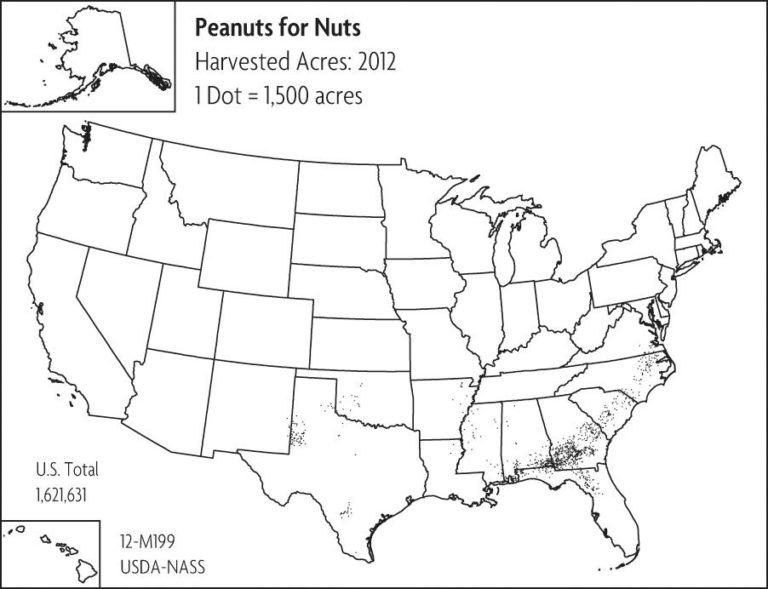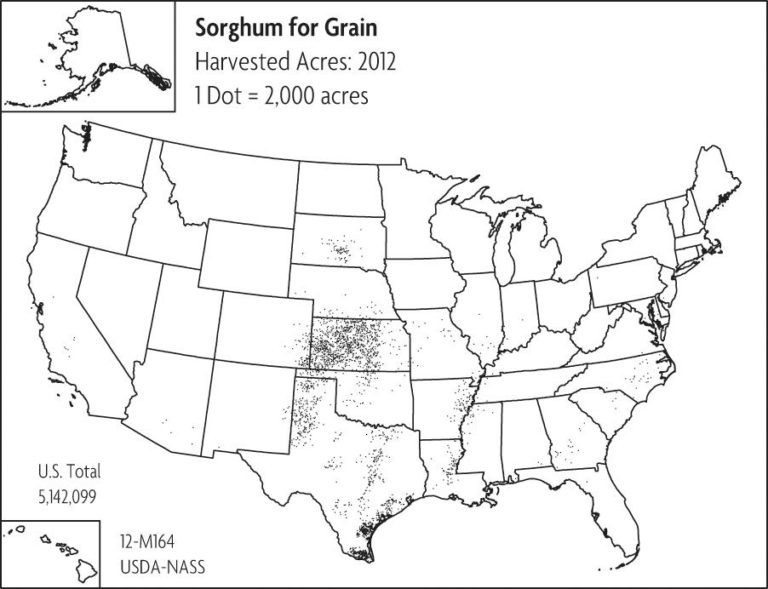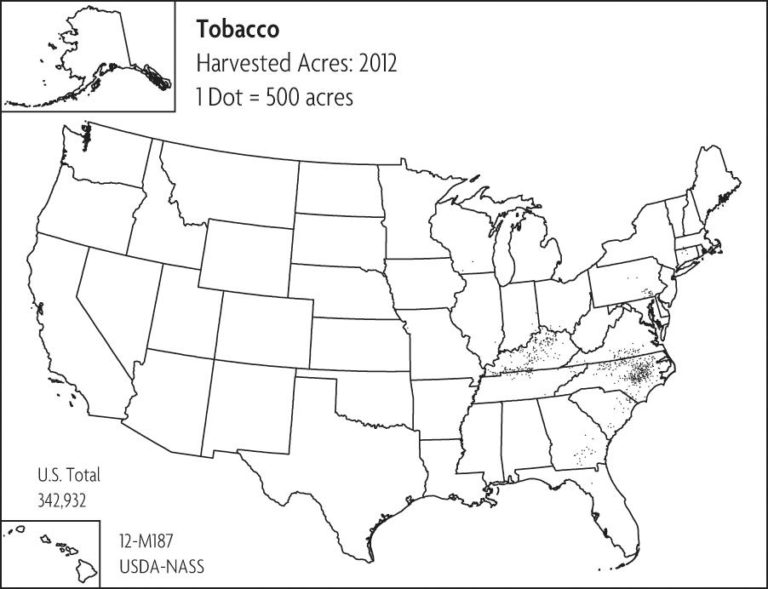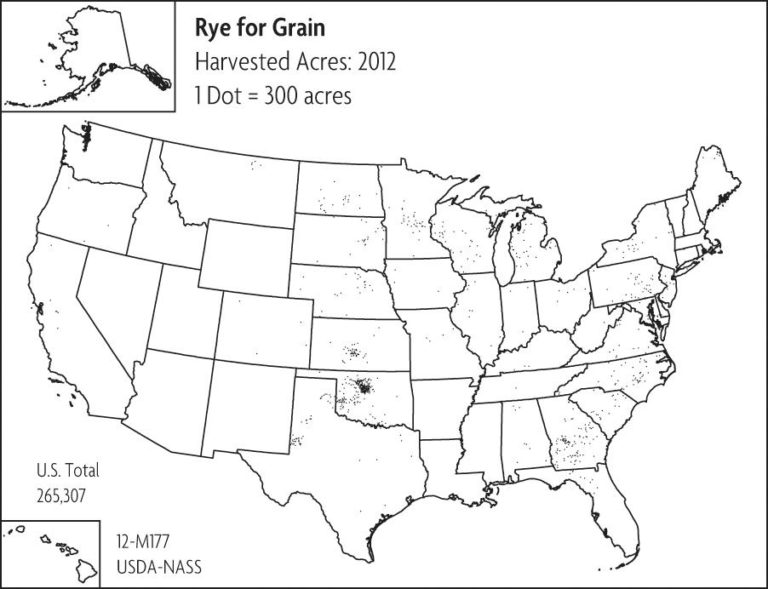Cash crops commonly grown in the Southeast work well in two-, three- and four-year rotations, and with cover crops (Table 7.2). They can be grown using conservation tillage but have historically been grown in monoculture systems.
The following sections discuss growth habits and Southeast production considerations for soybeans, hay, corn, wheat, cotton, rice, peanuts, sorghum, tobacco and rye. Planting and harvesting windows, and preferred soil types, are mentioned. Maps showing harvested-acreage density in the United States are included for each crop.
Soybeans
Soybeans are grown on virtually any soil type and are easily adapted to numerous rotations (Table 7.2). They are grown throughout the Southeast, with the densest production in the eastern parts of Virginia and the Carolinas (Figure 7.2). Soybeans are planted as full season or are double-cropped from March to July and harvested from September to December. Plant and harvest dates depend on the variety chosen and the crop rotation. Soybeans are commonly grown on marginal soils but are highest yielding on fertile, well-drained soils. Soybeans are legumes so nitrogen fertilizer is not needed.
High-yielding soybeans remove considerable amounts of potassium and phosphorus, as well as other macronutrients and micronutrients, from the soil. In many rotations, such as a rotation with winter wheat for grain>double-cropped soybeans>winter fallow>corn>winter wheat for grain, macronutrients such as potassium and phosphorus are often applied prior to planting winter wheat or corn. These applications usually meet soybean needs unless the whole plant is harvested, removing the nutrients [17]. Nitrogen mineralized from soybean residues is available for the following winter wheat crop and corn crop. Soil nutrient concentrations and pH are monitored with soil tests through university or private laboratories. Nutrient application rates are based on soil test results. Nutrients are added prior to soybean planting if needed.
Soybean varieties are divided into maturity groups (Group 00 to VIII) and are grown from southern Canada (Group 00, shortest season) to the southern United States (Group VIII, longest season). Most soybean varieties grown in the Southeast come from Group III to Group VIII [4]. Local day length and temperature control the length of the plant’s vegetative stage and timing of flowering. Varieties with shorter seasons are used in double-crop rotations where a summer soybean crop follows a winter cereal crop such as barley (Hordeum vulgare L.), rye or soft-red-winter wheat. For maximum yields, production is managed to utilize the entire length of the growing season.
Soybean farmers were early adopters of conservation tillage systems. Double-cropped soybean systems were successful because cereal-crop residues from barley, soft-red-winter wheat, or rye improved fertility, no-till planters were available, disease issues were minimal when compared to other crops, and herbicides were readily available. In the United States in 1989, approximately 55 percent of double-cropped soybeans were planted using conservation tillage techniques, and this number jumped to nearly 80 percent by 2014 (Figure 7.3). Producers in the Southeast adopted conservation tillage techniques even faster. Since 1989 in Virginia, over 95 percent of double-cropped soybeans were planted using conservation tillage techniques [7, 20].
Hay
Hay is grown across the Southeast, often in regions or soils less conducive to other cash crop production (Figure 7.4). “Hay” is comprised of several species that range from legumes to grasses, cool season to warm season, annual to perennial, and difficult-to-establish to invasive. The varieties selected depend on local conditions and farm goals. Hay is sometimes included in yearly rotations as a cover crop or as a winter cash crop, such as mixtures of oats and clovers.
Hay reduces erosion, builds soil structure and adds organic matter. Deep-rooting hay species take up nutrients deep in the soil profile and incorporate them into its plant biomass. In areas where livestock production dominates, hay is used to recycle nutrients from manure back into plant biomass for livestock feed. Recent research is utilizing the hay production system to improve overall soil quality and nutrient cycling. Depending on farm needs, the hay cropping system now has many uses that range from cover crops for grazing or baling for feed, to projects that are taking an entire field out of production for a three-year period. These perennial hay cover crops utilize routine hay mixtures with complementary characteristics, such as alfalfa, orchardgrass and clover, with the overall biomass returning to the soil for carbon sequestration and nitrogen additions. Nitrogen-fixing alfalfa and clover provide fertility for the nitrogen-scavenging orchardgrass. The orchardgrass provides significant residue for soil protection and addition of organic matter. A benefit of the hay mixture is that the seeds can be mixed and planted at the same time. Although the mixture generally performs better if planted in the fall, it can also be planted in early spring.
Corn
Corn was first cultured in Mexico and was initially grown in the Southeast by Native Americans. Production has been revolutionized over time through extensive research. Corn is grown throughout the Southeast on a wide range of soils (Figure 7.5). It is planted from March to May and harvested from August to October. The most productive soils are loam and silt-loam soils, which provide excellent nutrient-holding potential as well as water-holding capacity.
For successful field corn production, meaning corn for grain, follow these recommendations adapted from Boone, 1991 [4]:
- Use a hybrid adapted to the local climate with a high disease tolerance.
- Use fertilization techniques recommended for conservation tillage systems including proper nitrogen placement and application timing to reduce losses from immobilization and volatilization.
- Use a plant population appropriate for the hybrid and soil.
- Time field operations so that seed germination, fertilizer application, and pest and disease scouting occur when recommended for local conditions.
- Control weeds, insects and diseases common with the cool, wet and undisturbed soils found in conservation tillage systems.
Corn takes considerable management on sandy soils because it has a high water requirement during June and July, which are traditionally hot, dry months in the Southeast. Sandy soils in the Southeast Coastal Plain have low water-holding capacities [10]. Corn is not drought tolerant and even short dry spells can cause significant yield reductions. Without irrigation, a droughty situation may result in low yields and financial loss. Crops such as grain sorghum (Sorghum bicolor), cotton and soybeans have lower water requirements and are preferred for rotations on sandy soils.
Nitrogen management is an important consideration for corn crops grown in conservation tillage rotations. Sandy soils in the Southeast have inherently low fertility. A legume cash crop or cover crop is included in rotations to assist with nitrogen fixation as part of overall nitrogen fertility management. Split application of nitrogen, first at planting and then when the corn is knee high, significantly reduces nitrogen losses via leaching, runoff, immobilization and volatilization. With split application, nitrogen is available for crop establishment with the at-planting application and later in the season with the knee-high application when rapid nitrogen assimilation occurs.
Wheat
The types of wheat grown in the United States include hard-red-winter wheat, soft-red-winter wheat, white wheat, hard-red-spring wheat and durum wheat (Triticum durum). Wheat prefers well-drained soils and is commonly grown in arid regions west of 95°W longitude. However, soft-red-winter wheat is predominantly grown in the northern stretch of the Southeast that includes Virginia, North Carolina, South Carolina and Tennessee (Figure 7.6).
Soft-red-winter wheat is commonly seeded from October to December and harvested from May to July. Successful production focuses on yield-building factors such as variety selection, plant nutrition and precision planting, as well as yield-protecting factors including weed control, insect control, disease control and harvest management [1]. Yield is determined by the number of kernels per head, weight per kernel and heads per acre.
Wheat grown in conservation tillage systems has increased dramatically in recent years with the advent of equipment such as grain drills that can penetrate thick crop residue from the previous crop, such as corn stover, and allow good plant establishment. By 2012, over 85 percent of wheat acreage in the Eastern United States was grown using conservation tillage techniques [7, 21].
When growing soft-red-winter wheat in conservation tillage systems, avoid yield reductions by addressing system-management challenges. High-disease pressure, especially following corn or in rotations that incorporate cereal cover crops, can be problematic and is now a common occurrence. Immobilization and volatilization of spring-applied nitrogen can be an issue due to significant corn stover remaining on the soil surface. This adds carbon, which increases the system’s C:N ratio. A higher C:N ratio along with urease enzymes from the fertilizer may cause volatilization. Seed germination, plant growth and root growth may be delayed because soil warming under residue is delayed.
Wheat is also grown as a winter cover crop in conservation tillage systems; it produces ample biomass, protects the soil surface and takes up inorganic nitrogen from the soil profile. However, research has demonstrated that continuous wheat/cereal grain rotations can aggravate wheat disease problems, such as take-all (Gaeumannomyces graminis var. tritici). When wheat, or any crop, is being evaluated for a rotation, assess its impact on the timing of field operations and the scouting for pests and diseases.
Cotton
Cotton is a warm-season perennial fiber crop grown as an annual in the Southeast. In the Southeast, production is densest in the Coastal Plain region (Figure 7.7). American-upland cotton varieties require approximately 180 frost-free days, warm climatic conditions, ample moisture and well-drained soils [4]. Similar to corn and full-season soybeans, cotton is planted from April to May and harvested from September to November. Local seed dealers can help identify cotton varieties suitable for local conditions and the crop rotation.
Due to the warm, moist growing conditions, disease pressure is significant in cotton rotations. When cover crop residues are left on the soil surface, disease pressure increases further because the soils take longer to heat in the spring and ground cover holds moisture next to the seedlings. To reduce the disease pressure that occurs in no-till systems, cotton is planted using strip-tillage. The narrow tilled area provides a warm, clean and consistent seedbed for seed placement 0.5–1 inch deep.
Cotton has long been king in the Southeast and is known to be hard on soils, meaning that cotton-monoculture fields were apt to erode, lose nutrients and lose productivity. This occurs because minimal residue is left on the soil surface following cotton harvest. Adding a high-residue winter cover crop such as rye protects the soil, adds organic matter and recycles nitrogen applied to the previous cotton crop. If cover crops are allowed to grow until early heading, biomass production increases. To increase biomass further, nitrogen fertilizer is applied. The nitrogen added becomes available to the following cotton crop through mineralization of organic matter during the growing season [18, 19].
Peanuts
Peanuts (Arachis hypogaea), a legume, are grown in the Coastal Plain region of the Southeast in sandy-textured, well-drained soils (Figure 7.8). Peanuts are planted from April to May and harvested prior to frost, from September to October. When grown using conventional tillage, the soil is tilled to loosen the soil surface. This allows the peanut pegs to penetrate the ground where they grow into the actual peanut pod and seed. A moldboard plow is used to incorporate residue for disease reduction and to reduce the amount of foreign material in harvested peanut pods.
In recent years, research has found that peanuts can be raised using conservation tillage techniques including rotation with high-residue cover crops (Table 7.2). Peanuts are planted using strip-tillage to allow peanut pegs to be planted in a clean and loosened soil. When peanuts follow corn in rotation, with or without a cover crop, corn stover and other residues are typically incorporated to reduce problems with foreign material at the point of sale, to assist with disease management and to loosen soil around the plant to facilitate pegging.
Peanut rotations work well with double-cropped wheat and soybeans. However, research in North Carolina demonstrated that adding soybeans to peanut rotations may negatively impact peanut yields [13]. The research also found that four-year rotations, even with soybeans, had yields superior to long-term monoculture production. Peanuts are grown in rotation with small grains, cotton and corn to help with disease, insect and weed problems.
Sorghum
Sorghum (Sorghum bicolor) is a grass species commonly grown in the Midwest, and acreage is increasing in areas of the Southeast (Figure 7.9). In the Southeast, sorghum is typically planted from April to May and harvested August through November. Well-drained soils are preferred. Sorghum, like corn, is used as livestock feed and is an alternative to corn in drought-prone areas, such as areas with sandy-loam, loamy-sand, and sand soils. Production practices for sorghum are comparable to corn with similar pests and fertility needs. Sorghum is treated similar to corn in conservation tillage systems. However, harvest and storage for grain sorghum are more difficult because the grain heads do not dry uniformly in the field and it is difficult to pass air through stored sorghum grain.
Tobacco
Tobacco (Nicotiana tabacum) is a high-value crop with a long history in conventional tillage production systems. It grows well in various soil types and is typically planted from April to May and harvested July through August. Due to high labor costs and maintenance levels, tobacco is commonly grown on less acreage per farm when compared to other cash crops. Most tobacco production in the Southeast occurs in southern Virginia and North Carolina (Figure 7.10). Similar to other high-value crops, rotations are generally less important for pest control, but a proper rotation can significantly reduce disease pressure. Crop income covers the costs of the herbicides, insecticides, fungicides and fertilizers needed for high yields and quality tobacco leaves.
Historically, tobacco was grown using conventional tillage because the soft, bare soil was conducive to transplanting tobacco plants, reducing weed and disease pressure, and warming soil early in the spring. In recent years, strip-till has become more commonplace. The row is strip-tilled to assist with plant establishment, but row middles are left undisturbed. This reduces runoff and erosion, and increases soil organic matter. Strip-till requires only minor modifications to transplanting equipment, and soil fumigants can be applied simultaneously with the strip-till machinery. No-till tobacco systems have not been successful because available transplanting equipment does not work in heavy residue.
Rye
Rye is a cereal grain grown extensively as a winter cover crop as well as for grain. In the Southeast, most production occurs in the Coastal Plain region (Figure 7.11). Rye is a winter annual and an excellent substitute for wheat on marginal soils. When compared to wheat, its yield is greater on poor soils and it is more cold and drought tolerant. When grown for grain, rye is typically planted from September through November and harvested May through June. Earlier harvest than winter wheat allows the producer to begin planting double-cropped soybeans sooner. This is often cited as a reason for increased soybean yields.
Rye is a superior winter cover crop; it has excellent winter hardiness and produces relatively large amounts of persistent mulch. It is fairly easy to kill with herbicides, has allelopathic properties on weeds and “catches” more nitrogen from the soil profile than other cereal crops. These attributes reduce pollution, increase fertilizer efficiency, improve soil structure and increase cash crop yield [5, 8, 9, 15, 18, 19].
Research in Alabama investigated the impact of tillage timing, tillage depth and winter cover crops on cotton yields. A rye cover crop was the most critical factor in increasing yields of conservation-tillage cotton in the Tennessee Valley [16]. Waiting until early heading before termination of the rye cover crop is ideal for maximum biomass production. At this late growth stage, mechanical termination with a roller/crimper is an option instead of termination with chemicals such as glyphosate [2]. If maximum biomass production is desired, rye is a better choice than other cover crops or fallow. Rye increases soil tilth and rotation productivity while reducing nutrient and sediment losses that occur on fallow winter fields.

